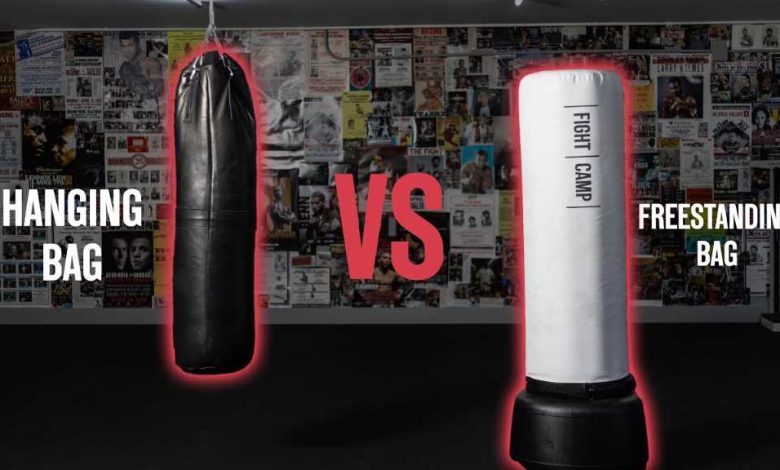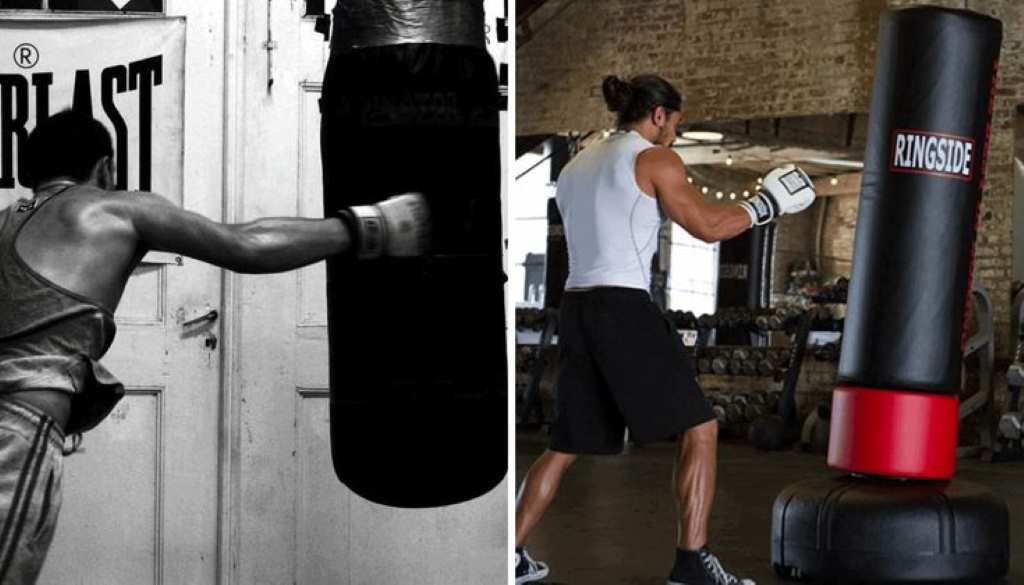
The quest for the perfect punch bag is a pivotal moment for any aspiring boxer, martial artist, or fitness enthusiast. It’s a tool that will transform your training, elevate your skills, and unleash your inner fighter. But with two distinct options – freestanding and hanging bags – the choice can be daunting. Fear not! This comprehensive guide on freestanding vs hanging punch bags will delve into the strengths and weaknesses of each type, equipping you with the knowledge to make an informed decision.
Freestanding Punch Bags: Convenience and Mobility
Freestanding bags have emerged as a popular choice for home gyms, thanks to their convenience and mobility. They typically consist of a weighted base filled with sand or water, supporting an upright striking surface.
Pros:
- Easy Installation: Setting up a freestanding bag is a breeze. Simply fill the base with the desired material, and you’re ready to rumble. No drilling, no hanging, no fuss.
- Portability: Want to move your workout to the backyard or garage? No problem! Freestanding bags can be easily relocated, offering flexibility for your training routine.
- Reduced Noise: Compared to hanging bags, freestanding options tend to generate less noise, making them more suitable for apartment dwellers or those with noise-sensitive neighbors.
- Variety: Freestanding bags come in various shapes and sizes, catering to different training needs. Some models even include additional striking surfaces for practicing kicks and elbows.
Cons:
- Stability: One of the primary concerns with freestanding bags is their stability. If not adequately weighted or if struck with significant force, they can tip over or slide, interrupting your flow.
- Limited Swing: Unlike hanging bags, freestanding options don’t offer the same natural swinging motion. This can affect the realism of your training, particularly when practicing footwork and timing.
- Price: Freestanding bags tend to be pricier than their hanging counterparts, due to their more complex construction and features.
Hanging Punch Bags: Realism and Durability
Hanging bags, the traditional choice for boxing gyms, are renowned for their realistic feel and durability. They are typically suspended from a ceiling or wall mount, allowing for a natural swinging motion that mimics a real opponent. For younger athletes, a children punching bag can be an excellent option to introduce them to the sport. Discover more about the benefits and features of different punching bags to find the right fit for all ages.
Pros:
- Realistic Movement: The swinging motion of a hanging bag provides a more authentic training experience, forcing you to adjust your footwork, timing, and accuracy.
- Durability: Constructed with robust materials like leather or canvas, hanging bags are built to withstand heavy punishment. They are less likely to tip over or break compared to freestanding options.
- Power Development: The resistance offered by a hanging bag is ideal for developing punching power and improving your overall striking technique.
- Affordability: Hanging bags are generally more budget-friendly than freestanding options, making them an attractive choice for cost-conscious individuals.
Cons:
- Installation: Setting up a hanging bag requires a sturdy mounting point and some DIY skills. If you’re not comfortable with drilling or don’t have a suitable location, this could be a dealbreaker.
- Noise: The impact of strikes on a hanging bag can be loud, especially if not properly installed or if used in a shared living space.
- Space Requirements: Hanging bags need adequate clearance for swinging, which might not be feasible in smaller rooms or apartments.
Choosing the Right Bag for You
The ideal punch bag ultimately depends on your individual needs and preferences. Consider the following factors when making your decision:
- Available Space: If space is limited, a freestanding bag might be more suitable. However, if you have ample room, a hanging bag could provide a more realistic training experience.
- Budget: Hanging bags are typically more affordable, but if you’re willing to invest, a high-quality freestanding option could be worth considering.
- Training Goals: If developing power and realistic technique is a priority, a hanging bag might be the better choice. However, if convenience and portability are paramount, a freestanding bag could be more appealing.
- Noise Concerns: If noise is an issue, opt for a freestanding bag or invest in noise-reducing measures for a hanging bag.
Maximizing Your Training:
Regardless of which type you choose, here are some tips for maximizing your training:
- Proper Technique: Focus on proper punching technique, including footwork, body rotation, and impact. A qualified trainer can help you refine your skills.
- Warm-Up: Always warm up before hitting the bag to prevent injuries.
- Variety: Incorporate different punches, combinations, and angles into your routine to keep things interesting and challenging.
- Maintenance: Regularly inspect and maintain your bag to ensure its longevity and optimal performance.
With this freestanding vs hanging punch bags comprehensive guide, you’re now equipped to make an informed decision and select the perfect punch bag for your home gym. Whether you opt for the convenience of a freestanding model or the realism of a hanging bag, the most important factor is to get out there and start training!





